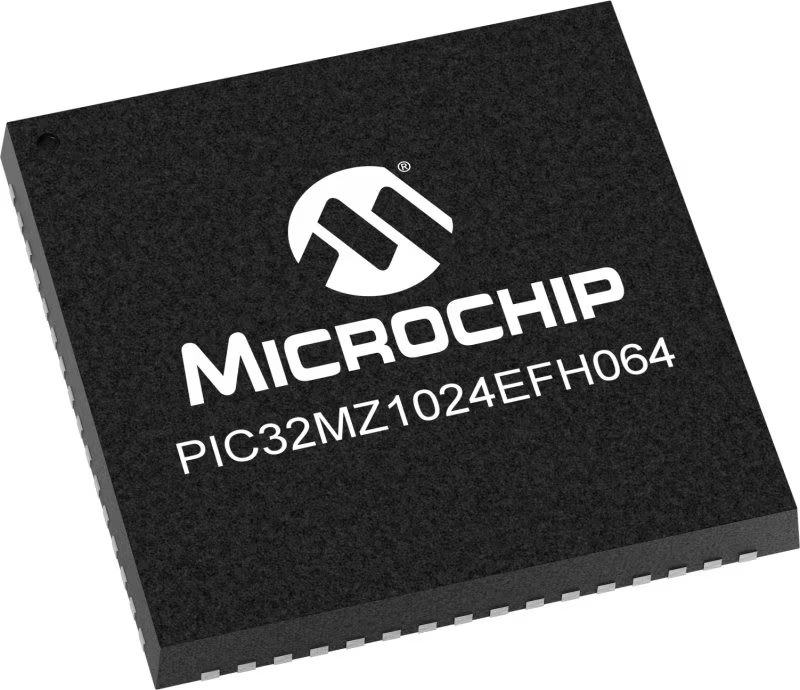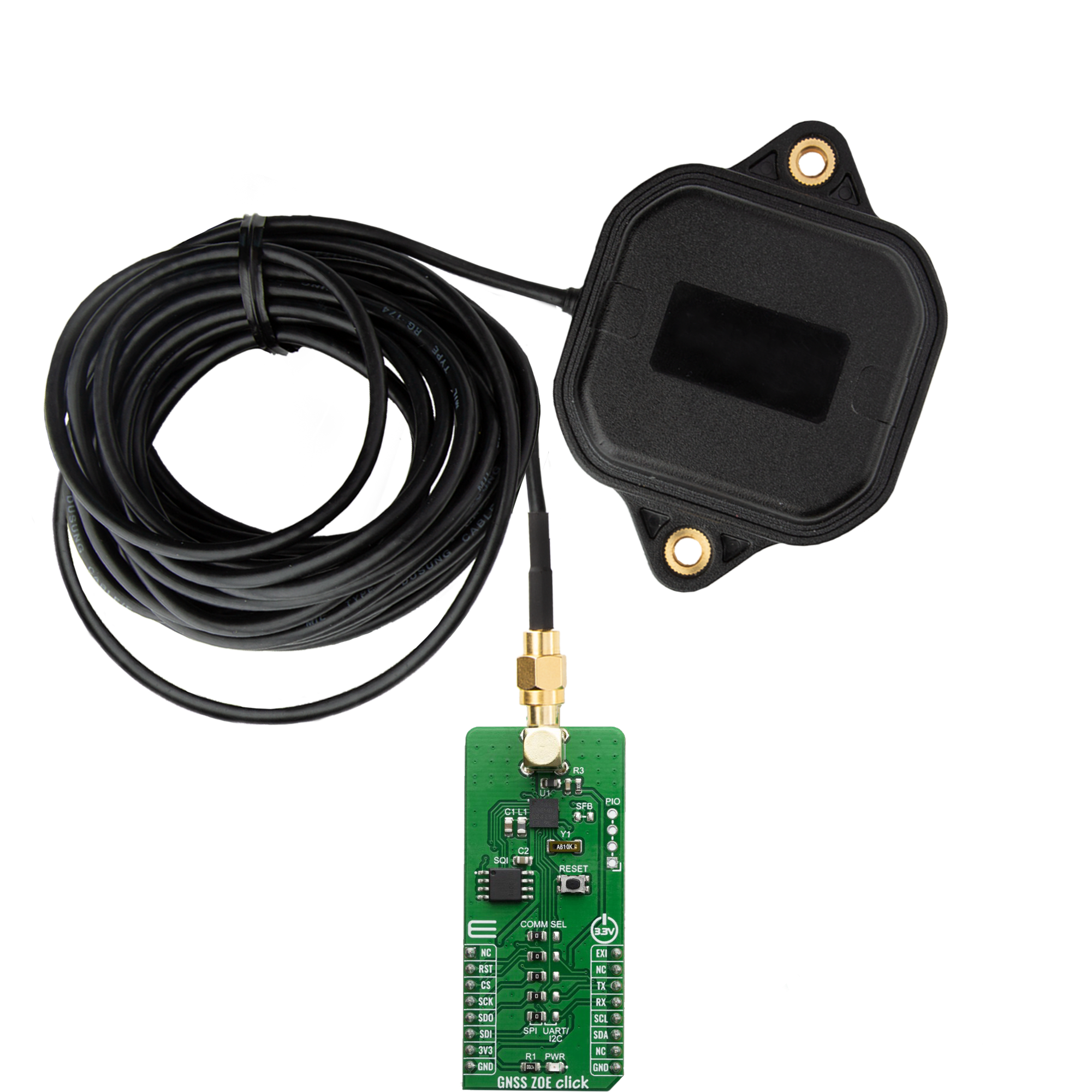Transform your engineering projects with our cutting-edge navigation solution designed to enhance precision and accuracy
A
A
Hardware Overview
How does it work?
GNSS ZOE Click is based on the ZOE-M8Q, u-blox's super small, highly integrated GNSS SiP (System in Package) modules based on the high-performing u-blox M8 concurrent positioning engine. The ultra-miniature form factor integrates a complete GNSS receiver, including an SAW filter, LNA, and TCXO. Incorporating ZOE-M8 into customer designs is simple and straightforward, thanks to the fully integrated design, single voltage supply, low power consumption, simple interface, and sophisticated interference suppression that ensure maximum performance even in GNSS-hostile environments. The ZOE-M8 GNSS SiPs are concurrent GNSS receivers that can receive and track multiple GNSS systems: GPS, Galileo, GLONASS, and BeiDou. Due to the dual-frequency RF front-end architecture, GLONASS or BeiDou can be processed concurrently with GPS and
Galileo signals, thereby providing reception of three GNSS systems. By default, the M8 receivers are configured for concurrent GPS and GLONASS, including SBAS and QZSS reception. If power consumption is a key factor, the receiver should be configured for a single GNSS operation using GPS, Galileo, GLONASS, or BeiDou and disabling QZSS and SBAS. Thanks to onboard 64 Mbit SQI flash memory, GNSS ZOE click can also be used in data logging applications. The data logging feature enables continuous storage of the flash memory's position, velocity, and time information. The information can be downloaded from the receiver later for further analysis or conversion to a mapping tool. Besides the data logging feature, the flash memory can also be used for the AssistNow Offline service. It allows users to conveniently download long-term orbit data
over the Internet and store it on the onboard 64 Mbit SQI flash memory. The ZOE-M8 SiP supports both SPI and I2C/UART communication protocol configurations. Therefore, this Click board™ has communication interface selection jumpers, named COMM SEL, to allow the user to set whether to use SPI communication or I2C/UART combination. Note that there are five SMD jumpers, all of which should be in the same position. This Click board™ can be operated only with a 3.3V logic voltage level. The board must perform appropriate logic voltage level conversion before using MCUs with different logic levels. Also, it comes equipped with a library containing functions and an example code that can be used as a reference for further development.
Features overview
Development board
PIC32MZ Clicker is a compact starter development board that brings the flexibility of add-on Click boards™ to your favorite microcontroller, making it a perfect starter kit for implementing your ideas. It comes with an onboard 32-bit PIC32MZ microcontroller with FPU from Microchip, a USB connector, LED indicators, buttons, a mikroProg connector, and a header for interfacing with external electronics. Thanks to its compact design with clear and easy-recognizable silkscreen markings, it provides a fluid and immersive working experience, allowing access anywhere and under
any circumstances. Each part of the PIC32MZ Clicker development kit contains the components necessary for the most efficient operation of the same board. In addition to the possibility of choosing the PIC32MZ Clicker programming method, using USB HID mikroBootloader, or through an external mikroProg connector for PIC, dsPIC, or PIC32 programmer, the Clicker board also includes a clean and regulated power supply module for the development kit. The USB Micro-B connection can provide up to 500mA of current, which is more than enough to operate all onboard
and additional modules. All communication methods that mikroBUS™ itself supports are on this board, including the well-established mikroBUS™ socket, reset button, and several buttons and LED indicators. PIC32MZ Clicker is an integral part of the Mikroe ecosystem, allowing you to create a new application in minutes. Natively supported by Mikroe software tools, it covers many aspects of prototyping thanks to a considerable number of different Click boards™ (over a thousand boards), the number of which is growing every day.
Microcontroller Overview
MCU Card / MCU

Architecture
PIC32
MCU Memory (KB)
1024
Silicon Vendor
Microchip
Pin count
64
RAM (Bytes)
524288
You complete me!
Accessories
GNSS Active External Antenna is a unique multi-band type of antenna coming from u-Blox that is the perfect selection for high precision GNSS applications, which require highly accurate location abilities such as RTK. The ANN-MB-00 is a multi-band (L1, L2/E5b/B2I) active GNSS antenna with a 5m cable and SMA connector. The antenna supports GPS, GLONASS, Galileo, and BeiDou and includes a high-performance multi-band RHCP dual-feed patch antenna element, a built-in high-gain LNA with SAW pre-filtering, and a 5 m antenna cable with SMA connector, and is waterproof.
Used MCU Pins
mikroBUS™ mapper
Take a closer look
Click board™ Schematic

Step by step
Project assembly
Track your results in real time
Application Output
1. Application Output - In Debug mode, the 'Application Output' window enables real-time data monitoring, offering direct insight into execution results. Ensure proper data display by configuring the environment correctly using the provided tutorial.

2. UART Terminal - Use the UART Terminal to monitor data transmission via a USB to UART converter, allowing direct communication between the Click board™ and your development system. Configure the baud rate and other serial settings according to your project's requirements to ensure proper functionality. For step-by-step setup instructions, refer to the provided tutorial.

3. Plot Output - The Plot feature offers a powerful way to visualize real-time sensor data, enabling trend analysis, debugging, and comparison of multiple data points. To set it up correctly, follow the provided tutorial, which includes a step-by-step example of using the Plot feature to display Click board™ readings. To use the Plot feature in your code, use the function: plot(*insert_graph_name*, variable_name);. This is a general format, and it is up to the user to replace 'insert_graph_name' with the actual graph name and 'variable_name' with the parameter to be displayed.

Software Support
Library Description
This library contains API for GNSS ZOE Click driver.
Key functions:
gnsszoe_reset_device- This function resets the device by toggling the RST pingnsszoe_generic_read- This function reads a desired number of data bytes from the modulegnsszoe_parse_gngga- This function parses the GNGGA data from the read response buffer
Open Source
Code example
The complete application code and a ready-to-use project are available through the NECTO Studio Package Manager for direct installation in the NECTO Studio. The application code can also be found on the MIKROE GitHub account.
/*!
* @file main.c
* @brief GNSS ZOE Click example
*
* # Description
* This example demonstrates the use of GNSS ZOE click by reading and displaying
* the GNSS coordinates.
*
* The demo application is composed of two sections :
*
* ## Application Init
* Initializes the driver and resets the click board.
*
* ## Application Task
* Reads the received data, parses the GNGGA info from it, and once it receives the position fix
* it will start displaying the coordinates on the USB UART.
*
* ## Additional Function
* - static void gnsszoe_clear_app_buf ( void )
* - static err_t gnsszoe_process ( gnsszoe_t *ctx )
* - static void gnsszoe_parser_application ( char *rsp )
*
* @author Stefan Filipovic
*
*/
#include "board.h"
#include "log.h"
#include "gnsszoe.h"
#define PROCESS_BUFFER_SIZE 300
static gnsszoe_t gnsszoe;
static log_t logger;
static char app_buf[ PROCESS_BUFFER_SIZE ] = { 0 };
static int32_t app_buf_len = 0;
static int32_t app_buf_cnt = 0;
/**
* @brief GNSS ZOE clearing application buffer.
* @details This function clears memory of application buffer and reset its length and counter.
* @return None.
* @note None.
*/
static void gnsszoe_clear_app_buf ( void );
/**
* @brief GNSS ZOE data reading function.
* @details This function reads data from device and concatenates data to application buffer.
* @param[in] ctx : Click context object.
* See #gnsszoe_t object definition for detailed explanation.
* @return @li @c 0 - Read some data.
* @li @c -1 - Nothing is read or Application buffer overflow.
* See #err_t definition for detailed explanation.
* @note None.
*/
static err_t gnsszoe_process ( gnsszoe_t *ctx );
/**
* @brief GNSS ZOE parser application.
* @param[in] rsp Response buffer.
* @details This function logs GNSS data on the USB UART.
* @return None.
* @note None.
*/
static void gnsszoe_parser_application ( char *rsp );
void application_init ( void )
{
log_cfg_t log_cfg; /**< Logger config object. */
gnsszoe_cfg_t gnsszoe_cfg; /**< Click config object. */
/**
* Logger initialization.
* Default baud rate: 115200
* Default log level: LOG_LEVEL_DEBUG
* @note If USB_UART_RX and USB_UART_TX
* are defined as HAL_PIN_NC, you will
* need to define them manually for log to work.
* See @b LOG_MAP_USB_UART macro definition for detailed explanation.
*/
LOG_MAP_USB_UART( log_cfg );
log_init( &logger, &log_cfg );
log_info( &logger, " Application Init " );
// Click initialization.
gnsszoe_cfg_setup( &gnsszoe_cfg );
GNSSZOE_MAP_MIKROBUS( gnsszoe_cfg, MIKROBUS_1 );
err_t init_flag = gnsszoe_init( &gnsszoe, &gnsszoe_cfg );
if ( ( UART_ERROR == init_flag ) || ( I2C_MASTER_ERROR == init_flag ) || ( SPI_MASTER_ERROR == init_flag ) )
{
log_error( &logger, " Communication init." );
for ( ; ; );
}
log_info( &logger, " Application Task " );
}
void application_task ( void )
{
gnsszoe_process( &gnsszoe );
if ( app_buf_len > ( sizeof ( GNSSZOE_RSP_GNGGA ) + GNSSZOE_GNGGA_ELEMENT_SIZE ) )
{
gnsszoe_parser_application( app_buf );
}
}
void main ( void )
{
application_init( );
for ( ; ; )
{
application_task( );
}
}
static void gnsszoe_clear_app_buf ( void )
{
memset( app_buf, 0, app_buf_len );
app_buf_len = 0;
app_buf_cnt = 0;
}
static err_t gnsszoe_process ( gnsszoe_t *ctx )
{
int32_t rx_size = 0;
char rx_buf[ PROCESS_BUFFER_SIZE ] = { 0 };
if ( GNSSZOE_DRV_SEL_UART == ctx->drv_sel )
{
rx_size = gnsszoe_generic_read( ctx, rx_buf, PROCESS_BUFFER_SIZE );
}
else if ( ( GNSSZOE_DRV_SEL_I2C == ctx->drv_sel ) || ( GNSSZOE_DRV_SEL_SPI == ctx->drv_sel ) )
{
if ( GNSSZOE_OK == gnsszoe_generic_read( ctx, rx_buf, 1 ) )
{
if ( GNSSZOE_DUMMY != rx_buf[ 0 ] )
{
rx_size = 1;
}
}
}
if ( rx_size > 0 )
{
int32_t buf_cnt = 0;
if ( ( app_buf_len + rx_size ) > PROCESS_BUFFER_SIZE )
{
gnsszoe_clear_app_buf( );
return GNSSZOE_ERROR;
}
else
{
buf_cnt = app_buf_len;
app_buf_len += rx_size;
}
for ( int32_t rx_cnt = 0; rx_cnt < rx_size; rx_cnt++ )
{
if ( rx_buf[ rx_cnt ] )
{
app_buf[ ( buf_cnt + rx_cnt ) ] = rx_buf[ rx_cnt ];
}
else
{
app_buf_len--;
buf_cnt--;
}
}
return GNSSZOE_OK;
}
return GNSSZOE_ERROR;
}
static void gnsszoe_parser_application ( char *rsp )
{
char element_buf[ 100 ] = { 0 };
if ( GNSSZOE_OK == gnsszoe_parse_gngga( rsp, GNSSZOE_GNGGA_LATITUDE, element_buf ) )
{
static uint8_t wait_for_fix_cnt = 0;
if ( strlen( element_buf ) > 0 )
{
log_printf( &logger, "\r\n Latitude: %.2s degrees, %s minutes \r\n", element_buf, &element_buf[ 2 ] );
gnsszoe_parse_gngga( rsp, GNSSZOE_GNGGA_LONGITUDE, element_buf );
log_printf( &logger, " Longitude: %.3s degrees, %s minutes \r\n", element_buf, &element_buf[ 3 ] );
memset( element_buf, 0, sizeof( element_buf ) );
gnsszoe_parse_gngga( rsp, GNSSZOE_GNGGA_ALTITUDE, element_buf );
log_printf( &logger, " Altitude: %s m \r\n", element_buf );
wait_for_fix_cnt = 0;
}
else
{
if ( wait_for_fix_cnt % 5 == 0 )
{
log_printf( &logger, " Waiting for the position fix...\r\n\n" );
wait_for_fix_cnt = 0;
}
wait_for_fix_cnt++;
}
gnsszoe_clear_app_buf( );
}
}
// ------------------------------------------------------------------------ END


































